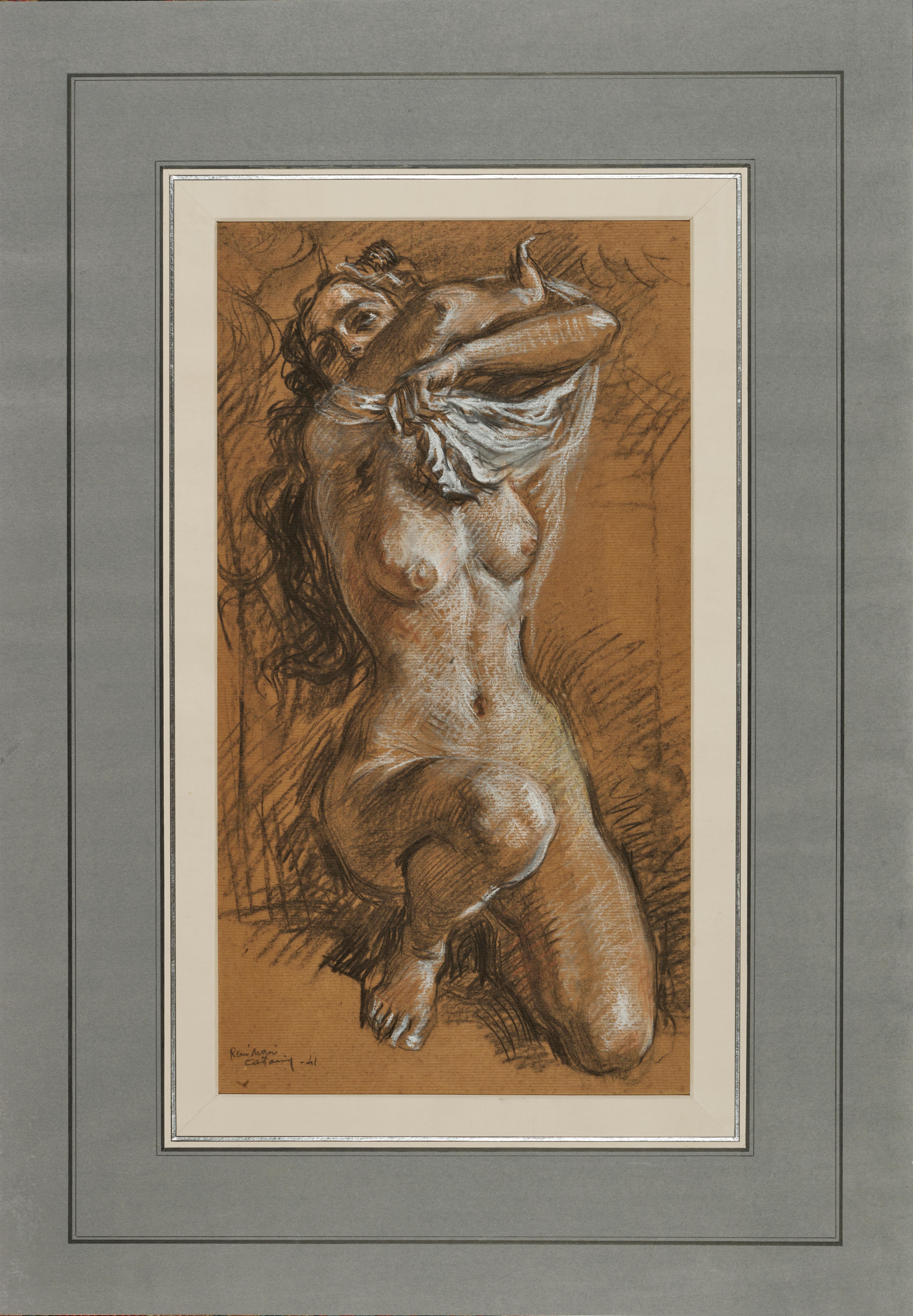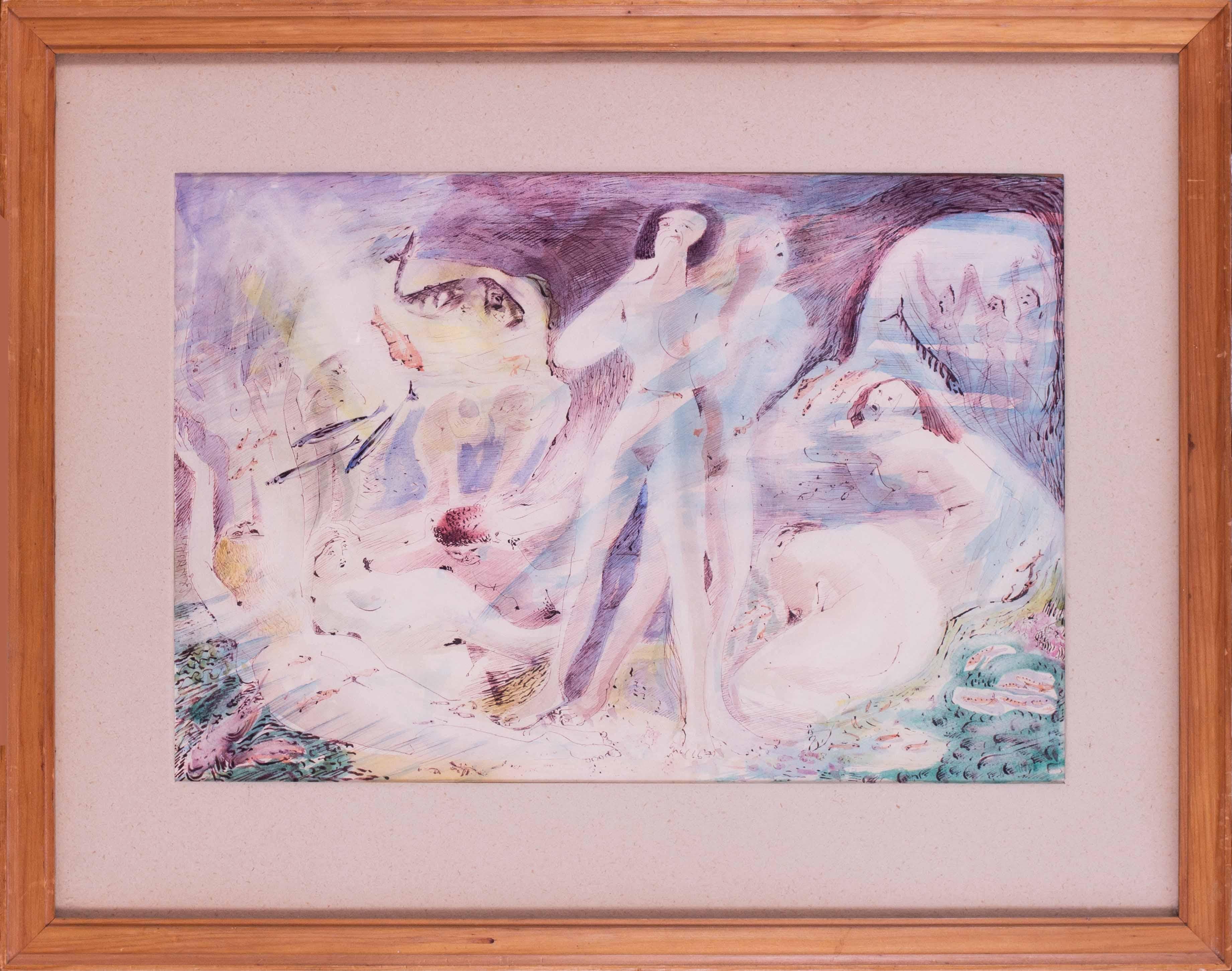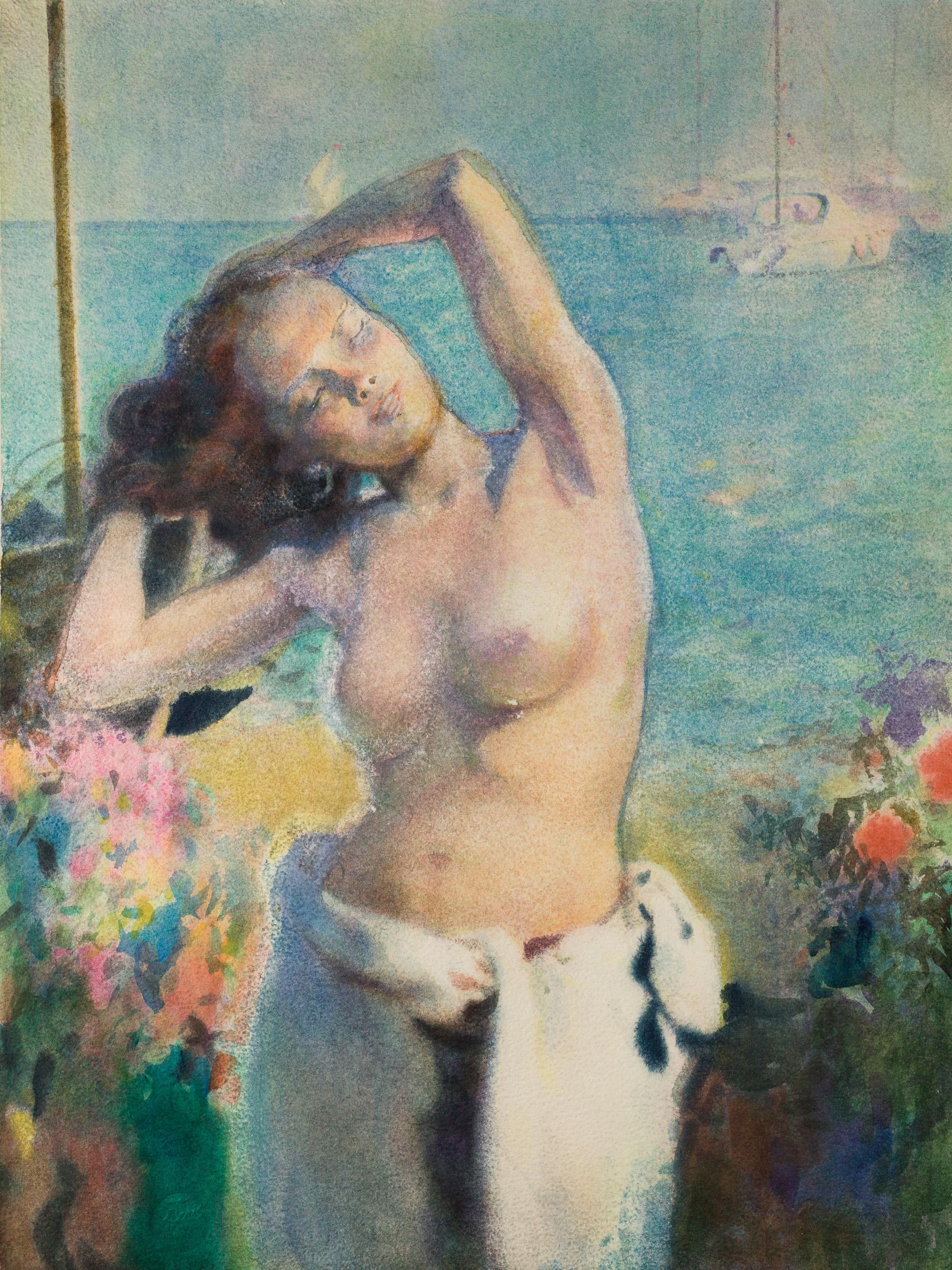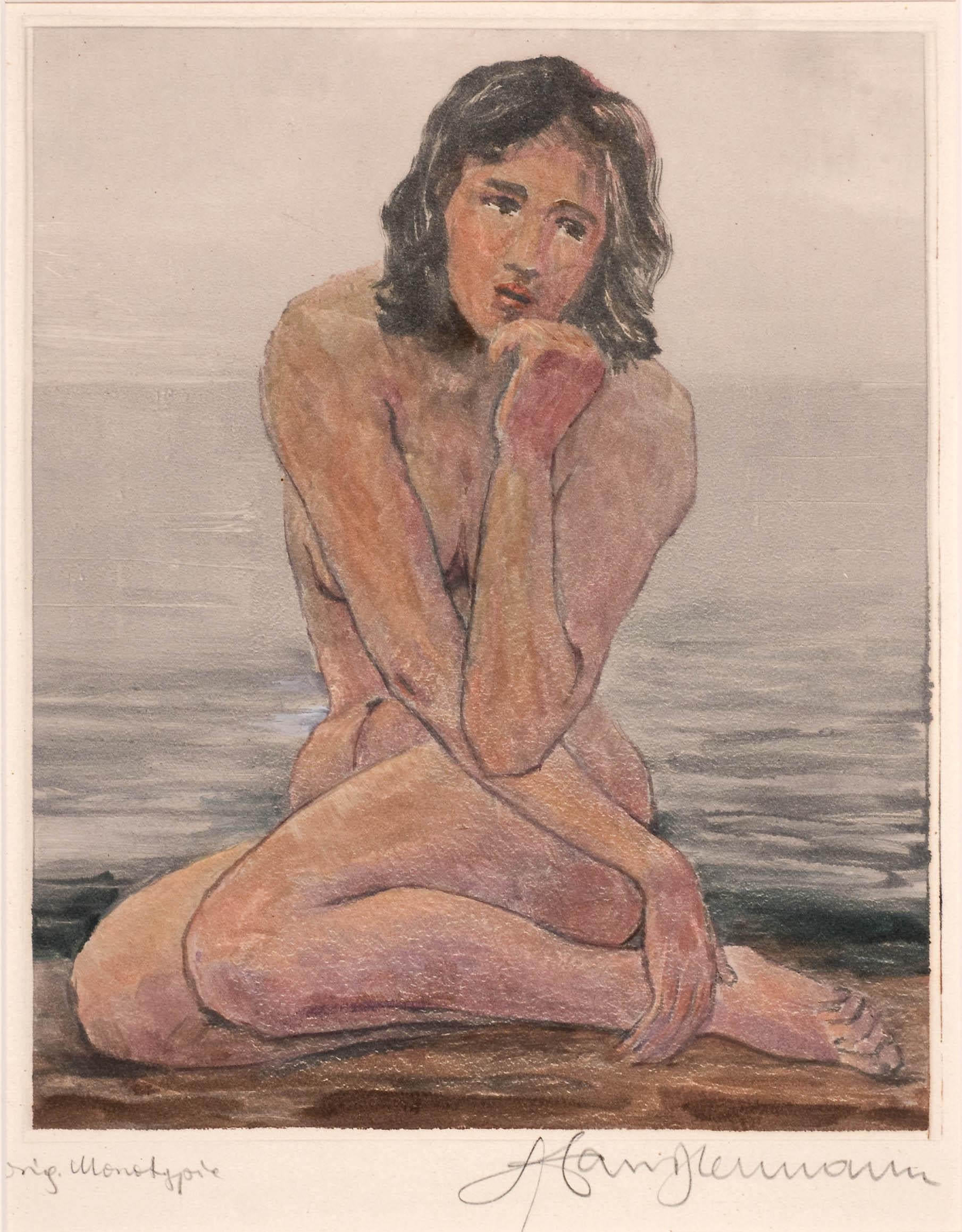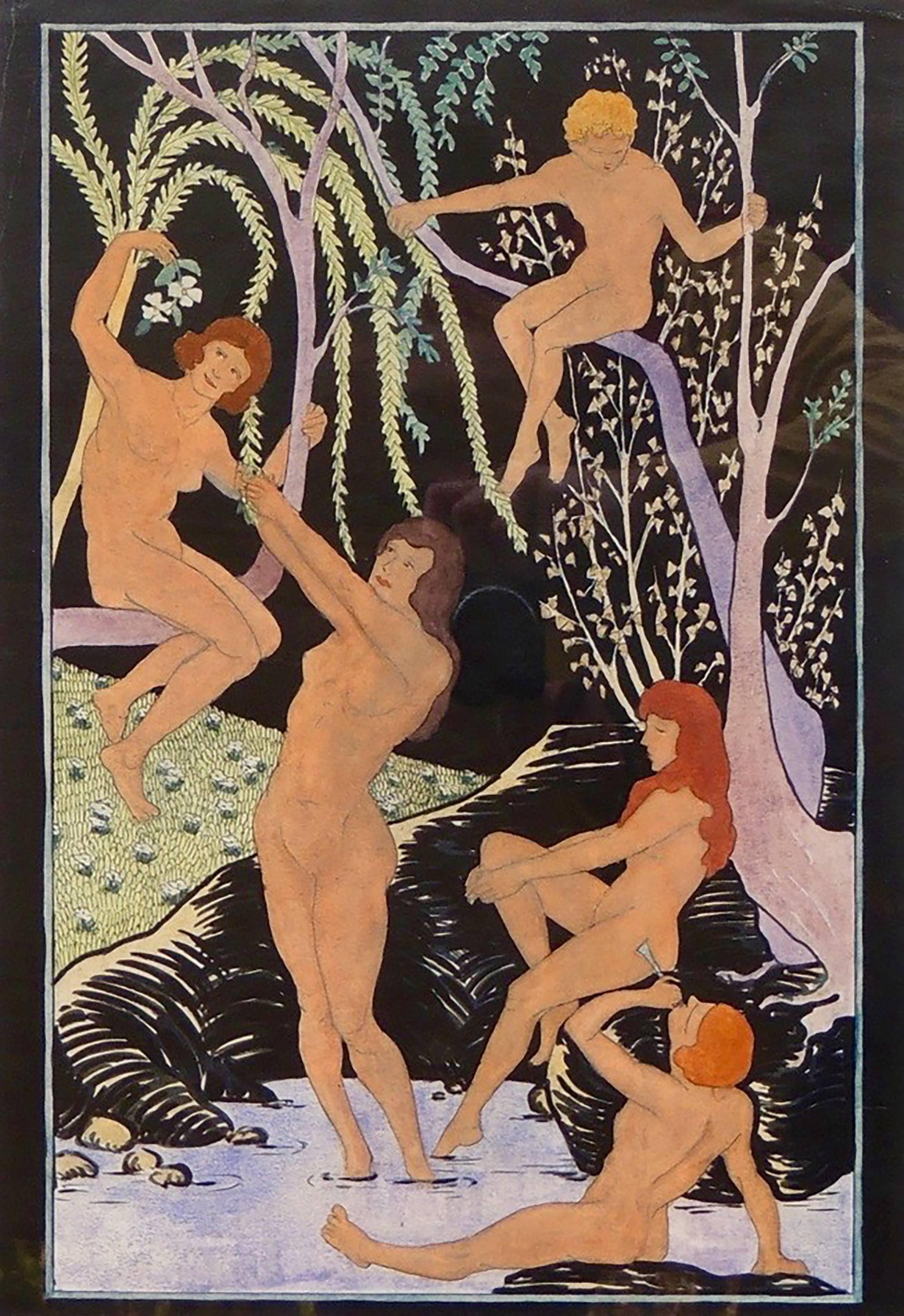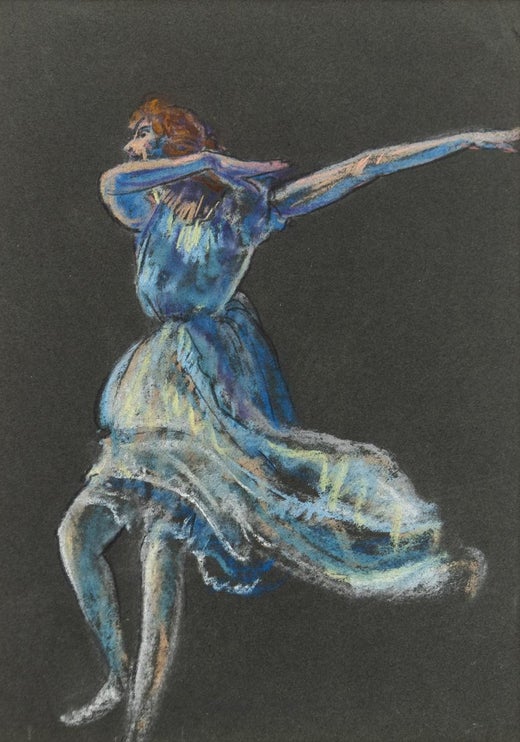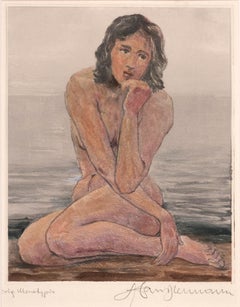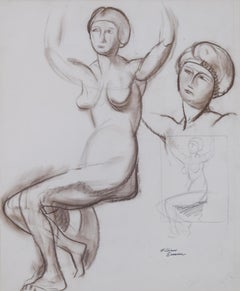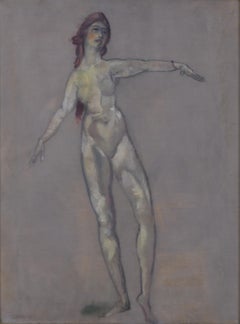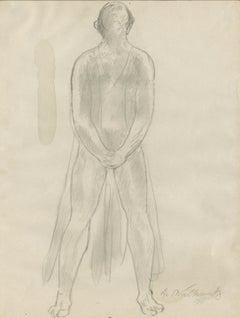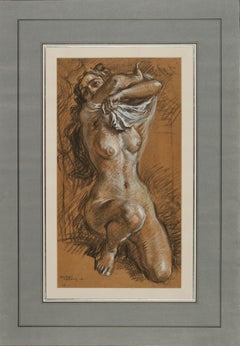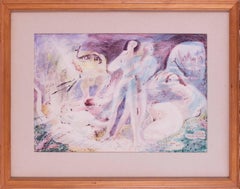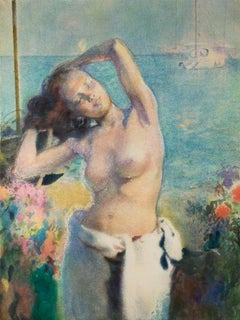Items Similar to South Spring Wind - Voice of Persephone
Want more images or videos?
Request additional images or videos from the seller
1 of 12
Arthur Bowen DaviesSouth Spring Wind - Voice of Persephonec. 1920
c. 1920
$5,500
£4,225.45
€4,854.99
CA$7,736.43
A$8,691.53
CHF 4,541.34
MX$106,084.24
NOK 57,661.75
SEK 54,276.39
DKK 36,229.74
About the Item
South Spring Wind - Voice of Persephone
Sanguine on paper heightened with white gouache over the entire sheet
Signed lower left
An important work on paper by the artist with extensive exhibition history (see labels). The artist used the theme of Persephone in paintings, drawings and prints.
Condition: Excellent
Image/Sheet size: 17 1/2 x 13 5/8 inches
Housed in an 8 ply rag mat
Provenance: Mildred Davies (the artist's widow)
Feragil Gallery, New York (label)
Montrsoe Gallery, New York (label)
FAR Gallery, New York (label)
Biography
Arthur B. Davies’s mystical, mysterious paintings hearken back to 19th-century romanticism, even while Davies aligned himself with American artists advancing the most radical ideals of their day. Davies was born on September 26, 1862, in Utica, New York, the son of English and Welsh parents who had immigrated to the United States in 1856. He first took art lessons as a teenager from a local landscape painter, Dwight Williams. By 1879 Davies's family had moved to Chicago, where he attended the Chicago Academy of Design. He interrupted his studies in the early 1880s to work in New Mexico and Mexico as a draftsman for a railway expansion company. Davies later attended the School of the Art Institute of Chicago and then moved to New York City, where he enrolled in the Art Students League. During his first years in New York he supported himself as a magazine illustrator. Davies’s work was shown at the American Art Galleries, the National Academy of Design, and in an exhibition of the American Watercolor Society. After his marriage to the physician Lucy Virginia Meriwether in 1892, Davies moved to a farm in Congers, in upstate New York, and commuted to his studio in the city. Acting on the recommendation of the dealer William Macbeth, the department store magnate Benjamin Altman provided financial support that enabled the young artist to make two trips to Europe. Davies had his first solo exhibition at Macbeth Gallery in 1896. In the early 1900s, Davies began to lead a double personal life: though he remained married and continued to visit his wife and children on weekends, he moved in with Edna Potter, a model and dancer, in New York. They assumed the alias of Mr. and Mrs. David A. Owen and kept their relationship, and their daughter, a secret until Davies’s death.
Davies's most distinctive works are the dreamlike, fantasy visions of female nudes standing in pastoral landscapes that he began to paint around 1900. These enigmatic subjects possess a distinctly classical flavor and have literary and mythological allusions. Such works have a strong affinity with symbolism and are often compared with those of the French artists Pierre Puvis de Chavannes (French, 1824 - 1898) and Odilon Redon (French, 1840 - 1916). Despite his style and subject matter—which had more of an affinity with the 19th century than the 20th—Davies joined the circle of young, progressive artists who gathered around Robert Henri (American, 1865 - 1929). Davies showed his work with theirs at the historic exhibition of The Eight at the Macbeth Gallery in 1908, and his paintings were included in the Exhibition of the Society of Independent Artists in 1910. He became president of the Society of Independent Artists in 1911 and played a pivotal role in organizing the Armory Show in 1913, which introduced Americans to the latest developments in European avant-garde art. Davies’s role as a fierce proponent of modernism in the work of others, rather than in his own artistic practice, was his greatest contribution to the field. After the Armory Show Davies briefly painted in a cubist-influenced style, but soon returned to the idyllic scenes for which he is best known. Davies also experimented with sculpture in a variety of styles and materials, including tapestry, and was an accomplished graphic artist. He served as advisor to the collector Lillie P. Bliss, helping her amass the collection that is now in the Museum of Modern Art, New York. Toward the end of his life he spent extended periods of time in Paris and Florence, Italy. He died of a heart attack in Florence on October 24, 1928.
Robert Torchia, Catherine Southwick
Courtesy National Gallery of Art, Washington
- Creator:Arthur Bowen Davies (1862-1928, American)
- Creation Year:c. 1920
- Dimensions:Height: 17.5 in (44.45 cm)Width: 13.63 in (34.63 cm)
- Medium:
- Movement & Style:
- Period:
- Condition:
- Gallery Location:Fairlawn, OH
- Reference Number:Seller: FA38851stDibs: LU14015836492
Arthur Bowen Davies
Arthur Bowen Davies was an American artist, strongly influenced by European avant-garde. His oeuvre is very eclectic and stretches from the most classical figurations close to the 19th-century tonalism of Whistler to the Pre-Raphaelites with Cubist and Fauvist quotations.
About the Seller
5.0
Recognized Seller
These prestigious sellers are industry leaders and represent the highest echelon for item quality and design.
Gold Seller
Premium sellers maintaining a 4.3+ rating and 24-hour response times
Established in 1978
1stDibs seller since 2013
802 sales on 1stDibs
Typical response time: <1 hour
Associations
International Fine Print Dealers Association
- ShippingRetrieving quote...Shipping from: Fairlawn, OH
- Return Policy
Authenticity Guarantee
In the unlikely event there’s an issue with an item’s authenticity, contact us within 1 year for a full refund. DetailsMoney-Back Guarantee
If your item is not as described, is damaged in transit, or does not arrive, contact us within 7 days for a full refund. Details24-Hour Cancellation
You have a 24-hour grace period in which to reconsider your purchase, with no questions asked.Vetted Professional Sellers
Our world-class sellers must adhere to strict standards for service and quality, maintaining the integrity of our listings.Price-Match Guarantee
If you find that a seller listed the same item for a lower price elsewhere, we’ll match it.Trusted Global Delivery
Our best-in-class carrier network provides specialized shipping options worldwide, including custom delivery.More From This Seller
View AllNude
Located in Fairlawn, OH
Nude
Monotype in colors, 1936
Signed, dated, and inscribed in pencil (see photo)
Annotated: "Orig. Monotype," dated Munchen 8 Sept. 1936"
Condition: Excellent
Image/plate size: 12 7/8 x 10 5/8 inches
Sheet size: 20 1/2 x 16 5/8 inches
Provenance: Frederick Baker, Inc., Chicago
Hans Hermann...
Category
1930s Romantic Nude Drawings and Watercolors
Materials
Monotype
$1,250
Female Nude Study
By William Sommer
Located in Fairlawn, OH
Female Nude Study
Graphite and crayon on wove paper, c. 1928
Signed with the Estate stamp "B" (see photo)
Provenance: Estate of the Artist
Edward Sommer (his so...
Category
1920s American Modern Nude Drawings and Watercolors
Materials
Crayon
Standing Female Nude
By Arthur Bowen Davies
Located in Fairlawn, OH
Standing Female Nude
Oil on canvas, c. 1910
Signed lower left corner (see photo)
Condition: Excellent
Housed in a 22K Gold Leaf Frame
Canvas size: 24 x 18 1/8 inche...
Category
1910s Ashcan School Nude Paintings
Materials
Oil
Isadora Duncan
By Abraham Walkowitz
Located in Fairlawn, OH
Isadora Duncan
Graphite with grey wash on paper mounted to cardstock
Signed and dated in pencil lower right (see photo)
Provenance: Charlotte Bergman, f...
Category
1910s American Modern Figurative Drawings and Watercolors
Materials
Graphite
Standing Female Nude
By William Sommer
Located in Fairlawn, OH
Standing Female Nude
Match stick and ink drawing, c. 1925
Signed with the estate stamp B
Sheet size: 21 x 16 inches
Created at the Kakoon Arts Klu...
Category
1920s American Modern Nude Drawings and Watercolors
Materials
Ink
Persephone
By Virginia Dehn
Located in Fairlawn, OH
Persephone
Oil on canvas, 1952
Signed lower left (see photo)
Titled reverse "Persephone" Signed "V. 52"
Exhibited: Columbus Gallery of the Arts label "71/30 Bt. 2", see label
Condition: two very small flakes of missing paint
Canvas size: 20 1/8 x 16"
Frame size: 20 7/8 x 16 3/4"
Provenance: Estate of the artist
Dehn Heirs
An important painting by the artist.
Virginia Dehn
From Wikipedia, the free encyclopedia
Virginia Dehn (1922-2005)
Virginia Dehn (née Engleman) (October 26, 1922 – July 28, 2005) was an American painter and printmaker. Her work was known for its interpretation of natural themes in almost abstract forms. She exhibited in shows and galleries throughout the U.S. Her paintings are included in many public collections.
Life
Dehn was born in Nevada, Missouri on October 26, 1922.] Raised in Hamden, Connecticut, she studied at Stephens College in Columbia, Missouri before moving to New York City. She met the artist Adolf Dehn while working at the Art Students League. They married in November 1947. The two artists worked side by side for many years, part of a group of artists who influenced the history of 20th century American art. Their Chelsea brownstone was a place where artists, writers, and intellectuals often gathered.
Early career
Virginia Dehn studied art at Stephens College in Missouri before continuing her art education at the Traphagen School of Design, and, later, the Art Students League, both located in New York City. In the mid-1940s while working at the Associated American Artists gallery, she met lithographer and watercolorist Adolf Dehn. Adolf was older than Virginia, and he already enjoyed a successful career as an artist. The two were married in 1947 in a private ceremony at Virginia's parents house in Wallingford, Connecticut.
Virginia and Adolf Dehn
The Dehns lived in a Chelsea brownstone on West 21st Street where they worked side by side. They often hosted gatherings of other influential artists and intellectuals of the 20th century. Among their closest friends were sculptor Federico Castellón and his wife Hilda; writer Sidney Alexander and his wife Frances; artists Sally and Milton Avery; Ferol and Bill Smith, also an artist; and Lily and Georges Schreiber, an artist and writer. Bob Steed and his wife Gittel, an anthropologist, were also good friends of the Dehns. According to friend Gretchen Marple Pracht, "Virginia was a glamorous and sophisticated hostess who welcomed visitors to their home and always invited a diverse crowd of guests..." Despite their active social life, the two were disciplined artists, working at their easels nearly daily and taking Saturdays to visit galleries and view new work.
The Dehns made annual trips to France to work on lithographs at the Atelier Desjobert in Paris. Virginia used a bamboo pen to draw directly on the stone for her lithographs, which often depicted trees or still lifes. The Dehns' other travels included visits to Key West, Colorado, Mexico, and countries such as Greece, Haiti, Afghanistan, and India.
Dehn's style of art differend greatly from that of her husband, though the two sometimes exhibited together. A friend of the couple remarked, "Adolf paints landscapes; Virginia paints inscapes." Virginia Dehn generally painted an interior vision based on her feelings for a subject, rather than a literal rendition of it.] Many of her paintings consist of several layers, with earlier layers showing through. She found inspiration in the Abstract Expressionism movement that dominated the New York and Paris art scenes in the 1950s. Some of her favorite artists included Adolf Gottileb, Rothko, William Baziotes, Pomodoro, and Antonio Tapies.
Dehn most often worked with bold, vibrant colors in large formats. Her subjects were not literal, but intuitive. She learned new techniques of lithography from her husband Adolf, and did her own prints. Texture was very important to her in her work. Her art was influenced by a variety of sources. In the late 1960s she came across a book that included photographs of organic patterns of life as revealed under a microscope. These images inspired her to change the direction of some of her paintings. Other influences on Dehn's art came from ancient and traditional arts of various cultures throughout the world, including Persian miniatures, illuminated manuscripts, Dutch still life painting, Asian art, ancient Egyptian artifacts...
Category
1950s American Modern Abstract Paintings
Materials
Acrylic
You May Also Like
Study for the Spring (preparatory to the Four Seasons) by René-Marie Castaing
Located in PARIS, FR
René-Paris Castaing, winner of the Grand Prix de Rome in 1924, left a large body of work, both sacred and secular. Many churches in the Pyrénées-Atlantiques, in South-West France still bear witness to the diversity of his talent. In 1942, he began a major decoration project for the Château de Diusse, in the north-east of the county, including an allegory of the four seasons. The vigorous pastel we are presenting here is a study for Spring, depicted as Flore undressing. This commission was a veritable swan song for the artist, who died a year later at the age of 47.
1. René-Marie Castaing, the great inter-war painter in Pau
René-Marie Castaing was born in Pau on December 16th 1896. His father, Joseph Castaing, was also a painter: he was the official portraitist of Pau's high society, which was particularly cosmopolitan at the end of the century, when many rich foreigners spent the winter in Pau, taking advantage of the mild weather to enjoy an outdoor lifestyle punctuated by hunting, horse ridings and golf.
René-Marie Castaing was admitted to the Ecole Nationale Supérieure des Beaux-Arts in Paris in April 1920 and entered the studio of Paul-Albert Laurens (1870-1934). In 1924, he was awarded the First Grand Prix de Rome for Painting, which earned him a stay at the Villa Médicis for more than three years. He then returned to Pau in 1928, where he lived until his death.
Castaing's work is marked by the academic tradition, in which drawing plays as important a role as painting. Although his drawings are often sketches that help to set up large painted compositions, they stand as independent artworks in which the artist fully expresses the vivacity of his talent.
Castaing was a fervent Christian and religious painting played an essential part in his work, as shown by the decorations he created for the churches of Bizanos, Borce, Bidache and Salies-de-Béarn. The painter also created several secular decorations, such as that for the dining room of the Villa Saint-Basil's in Pau in 1935, and the Hunting at the Albret’s time commissioned in 1940 by the Prefecture of Pau. The décor created in 1942-1943 for the Château de Diusse, a mansion located north-east of Pau, was his last large-scale décor, as the painter died shortly after its completion on December 8th 1943.
2. Description of the drawing
Our pastel depicts an eminently secular theme: Spring is embodied by Flore, crouching on the ground with one knee touching the ground. She reveals her ample bosom by removing her shirt, her arms raised above her shoulders to undress.
Given Castaing's classical training at the Beaux-Arts and the influence of ancient statuary...
Category
1940s Art Deco Nude Drawings and Watercolors
Materials
Pastel
Modern British 20th C watercolour drawing of Thetis laments by Hughes-Stanton
By Blair Hughes-Stanton
Located in Petworth, West Sussex
Blair Hughes-Stanton – ‘Thetis Laments’ 1952
The watercolour is signed by the artist lower right in pencil 'Blair HS' and dated (19)52. It was exhibited in June 1954 at The Leicester...
Category
20th Century English School Figurative Drawings and Watercolors
Materials
Ink, Watercolor
Sweet azure breeze
Located in Edinburgh, GB
Boris Akopian "Sweet azure breeze"
Category
1990s Nude Drawings and Watercolors
Materials
Paper, Watercolor
Helen Steinthal (1911-1991) - 20th Century Watercolour, Nudes in Colour
Located in Corsham, GB
A charming watercolour study of three nude figures in different poses on background representing earth, sea and air. Signed to the lower right. On paper.
Category
20th Century Nude Drawings and Watercolors
Materials
Watercolor
$244 Sale Price
20% Off
Nature Scene with Nudes
By Susan Flint
Located in Fort Washington, PA
Medium: Watercolor on Paper
Dimensions: 19.75" x 12.50"
Category
Early 20th Century Nude Drawings and Watercolors
Materials
Paper, Watercolor
Untitled, Modern Watercolor by Jane Bazinet
By Jane Bazinet
Located in Long Island City, NY
Jane Bazinet, American - Untitled, Year: 1980, Medium: Watercolor, signed, Size: 30 x 40 in. (76.2 x 101.6 cm), Frame Size: 32 x 42 inches
Category
1980s Modern Nude Drawings and Watercolors
Materials
Watercolor
More Ways To Browse
Antique Springs
Robert Spring
Antique Winder
Ashcan New York
American Ashcan
Early 20th Century Nude Female Paintings
Nude Daughter
Mexican Gouache
1920 French Nude Paintings
Robert Spring Watercolor
Altman Artist
Mexican Cubist
Arthur William Best
Antique Farm Prints
Mexican Antique Sculpture
Antique Advisor
Florence Henri
Pastoral Sculpture
